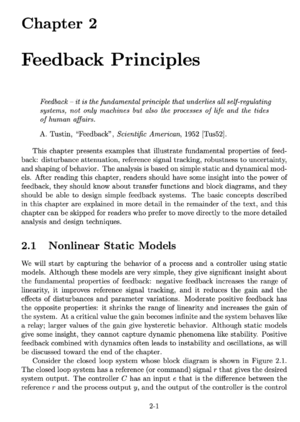Difference between revisions of "Feedback Principles"
| Line 4: | Line 4: | ||
|Previous chapter=Introduction | |Previous chapter=Introduction | ||
|Next chapter=System Modeling | |Next chapter=System Modeling | ||
| + | |First edition URL= | ||
|Chapter summary=This chapter presents examples that illustrate fundamental properties of feed- back: disturbance attenuation, reference signal tracking, robustness to uncertainty, and shaping of behavior. The analysis is based on simple static and dynamical mod- els. After reading this chapter, readers should have some insight into the power of feedback, they should know about transfer functions and block diagrams, and they should be able to design simple feedback systems. The basic concepts described in this chapter are explained in more detail in the remainder of the text, and this chapter can be skipped for readers who prefer to move directly to the more detailed analysis and design techniques. | |Chapter summary=This chapter presents examples that illustrate fundamental properties of feed- back: disturbance attenuation, reference signal tracking, robustness to uncertainty, and shaping of behavior. The analysis is based on simple static and dynamical mod- els. After reading this chapter, readers should have some insight into the power of feedback, they should know about transfer functions and block diagrams, and they should be able to design simple feedback systems. The basic concepts described in this chapter are explained in more detail in the remainder of the text, and this chapter can be skipped for readers who prefer to move directly to the more detailed analysis and design techniques. | ||
|Chapter contents=# Nonlinear Static Models | |Chapter contents=# Nonlinear Static Models | ||
Revision as of 21:25, 28 August 2021
| Prev: Introduction | Chapter 2 - Feedback Principles | Next: System Modeling |
This chapter presents examples that illustrate fundamental properties of feed- back: disturbance attenuation, reference signal tracking, robustness to uncertainty, and shaping of behavior. The analysis is based on simple static and dynamical mod- els. After reading this chapter, readers should have some insight into the power of feedback, they should know about transfer functions and block diagrams, and they should be able to design simple feedback systems. The basic concepts described in this chapter are explained in more detail in the remainder of the text, and this chapter can be skipped for readers who prefer to move directly to the more detailed analysis and design techniques.
Teaching MaterialsNone available Additional ExercisesNone available Frequently Asked QuestionsNone available ErrataNone reported |
Python CodeThe following Python scripts are available for producing figures that appear in this chapter.
See the software page for more information on how to run these scripts. Additional Information |
